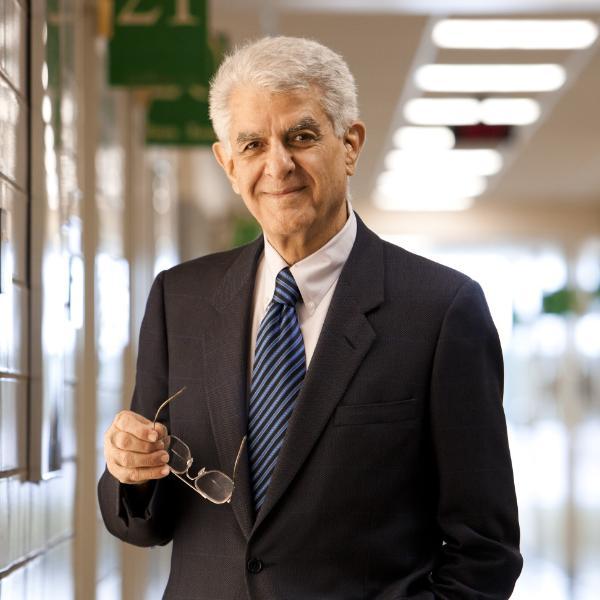
Bijan Safai, M.D., D.Sc.

Prior to joining NYMC, Bijan Safai, M.D., D.Sc., established a dermatology program at Memorial Sloan-Kettering Cancer Center (MSKCC) to include research, education and patient care. During his tenure, Dr. Safai developed programs devoted to research, management and teaching of various skin cancers. He instituted a skin cancer-screening initiative for the employees of MSKCC, which was adopted for the city of New York, and earned him a citation from Mayor Ed Koch of the city of New York. These initial steps helped him to consolidate the development of a comprehensive dermatology service at MSKCC.
In 1978, Dr. Safai was appointed chief of dermatology at MSKCC, where he was then able to expand his program to include specific research and clinical projects for various skin cancers, including lymphoma of the skin and Kaposi's Sarcoma. His laboratory investigation in Mycosis Fungoides led him to demonstrate for the first time, production of factors known today as cytokines, by epidermal keratinocytes. Dr Safai's investigative work on Kaposi's Sarcoma, published in 1978-1980, indicated a viral etiology, similar to CMV, for the disease, and its association with an immunological imbalance of the patient. A year later, in 1981, this was further confirmed by the appearance of Kaposi's Sarcoma among victims of the AIDS epidemic who were immune deficient, and the discovery of a new herpes virus, type 8, as the causative agent of Kaposi's Sarcoma in 1994.
Dr Safai’s early work on Kaposi's Sarcoma led him to be in the forefront of the initial investigators of the AIDS epidemic. Among many of his scientific contributions are the use of interferon in the treatment of AIDS- Kaposi's Sarcoma, his assistant and participation in the initial identification of the AIDS virus: HIV, identification and isolation of the HIV’s GP21 antigen and development of the first HIV serologic test and the first publication of the serological testing for the AIDS virus. Dr Safai also worked for the initial testing of HIV treatment using DDC, DDI. He raised the funding and organized the first international AIDS conference in Cold Spring Harbor, New York.
Dr. Safai served as the chief of dermatology service and director of its research program at MSKCC for more than 19 years and was promoted to the rank of professor at Cornell Medical College in 1984, and member of MSKCC in 1985.
In 1993, Dr. Safai accepted the position of professor and chair of the Department of Dermatology at New York Medical College where he has been involved with the education and training of dermatology residents and medical students ever since. Dr. Safai designed a well-defined curriculum and focused on standardizing the training program to meet ACGME’s requirements. He further expanded the program to include new management and therapeutic modalities for patientcare and dermatology training.
In February of 2012, Dr. Safai was elected president and chair of the Board of Directors of “Physician Affiliate group of New York (PAGNY). PAGNY is one of the largest physician groups in New York and the U.S., with more than 4,000 members of physicians and allied health care workers.
Dr. Safai has served on the NIH/NCI study sections, a variety of task forces and intramural review groups of NIH/NCI. He has served on the editorial boards of several journals. Dr. Safai has held the position of president of the New York Dermatologic Society and was the Chair of the New York Academy of Medicine, Dermatology section. He has received multiple national and international awards for excellence in his work. Dr. Safai established and served as the president of the Fisher Medical Foundation dedicated to the study of Alzheimer; the foundation provided initial funding for establishing Alzheimer Research Center at the Rockefeller University.
Education
- M.D., Tehran University School of Medicine
- Fellowship, Immunology, NYU Medical School, Memorial Sloan-Kettering Cancer Center.
- M.D., Tehran University, School of Medicine
- D.Sc., University of Gutenberg
Research
Dr. Safai is a practicing dermatologist, and his research is currently devoted to skin malignancies and stem cells of the skin. He has published more than 200 articles, reviews and book chapters. His textbook "Imunodermatology", published in 1981, defined the discipline and focused more attention on the fact that skin is “an immunological organ” and the very close relation between dermatology and immunology.
Publications
- Maskey AR, Sasaki A, Sargen M, et. al. "Breaking the cycle: a comprehensive exploration of topical steroid addiction and withdrawal." Frontiers in allergy, 6(), (2025) 1547923. doi: 10.3389/falgy.2025.1547923
- Safai B. "Editorial for the Special Issue "Cutaneous Biology, Molecular Dermatology and Dermatopathology"." International journal of molecular sciences, 26(6), (2025) . doi: 10.3390/ijms26062694
- Fruchtman H, Peterson D, Diamond S, et. al. "Mucosal angioleiomyoma: mucoscopic findings adding value to diagnosis." BMJ case reports, 18(2), (2025) . pii: e262999. doi: 10.1136/bcr-2024-262999
- Atak MF, Moon JY, Safai B, et. al. "Utilizing AI to Improve Healthcare Access and Address Disparities in Dermatology." International journal of dermatology, (), (2025) . doi: 10.1111/ijd.17670
- İsmail Mendi B, Kose K, Fleshner L, et. al. "Artificial Intelligence in the Non-Invasive Detection of Melanoma." Life (Basel, Switzerland), 14(12), (2024) . doi: 10.3390/life14121602
- Roster K, Fleshner L, Farabi B, et. al. "The association of Hidradenitis Suppurativa with comorbidities in underrepresented patient populations: An All of Us database analysis." Journal of the European Academy of Dermatology and Venereology : JEADV, (), (2024) . doi: 10.1111/jdv.20502
- Afvari S, Collet DA, Goyal A, et. al. "Geospatial analysis of dermatologist distribution and access among US seniors." JAAD international, 18(), (2024) 41-43. doi: 10.1016/j.jdin.2024.08.023

